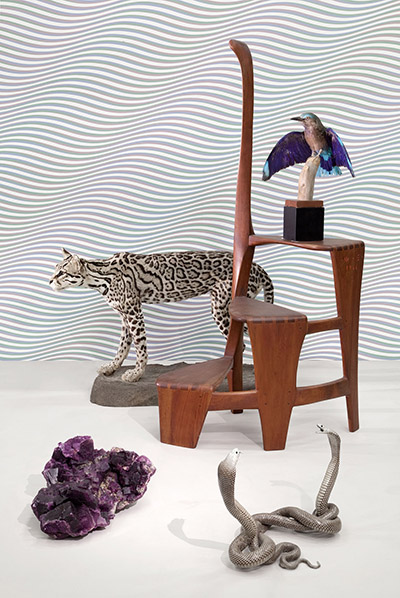
Inside the “Hall of Wonders” at Cranbrook
Bridget Riley, “Ch’i-Yün,” 1974; “Leopardus pardalis (Ocelot),” mid-twentieth century; Wharton Esherick, “Spiral Three-Step Ladder,” 1966; “Coracias garrulus (European Roller),” early twentieth century; “Fluorite crystal”; “Confronted Najas (Cobras),” early 20th century. Photo by PD Rearick, courtesy of Cranbrook Art Museum
Cranbrook Art Museum has a stellar lineup this winter, including a new exhibit co-curated by Shelley Selim, a 2013–2015 Jeanne and Ralph Graham Collections fellow, and Laura Mott, curator of Contemporary Art and Design. The pair teamed up for “The Cranbrook Hall of Wonders: Artworks, Objects, and Natural Curiosities,” an inspired installation in the tradition of the “Wunderkammer” (or “Cabinet of Curiosities”) that were all the rage during the rise of the natural sciences in the 16th century, and have been enjoying a popular resurgence lately, with vitrine art cropping up in contemporary art settings all over the map.
Cranbrook’s “Hall of Wonders” inverts the vitrine, with an open, modular exhibition design by Mark Baker that bestows remarkable fluidity to the installation, which features a dazzling array of objects from Cranbrook’s art and science museum collections, roughly segmented into four areas of classification: Camouflage & Homage, Balance & Collapse, Comfort & Conquest, and Travel Through Space & Time. Untethered from the traditional hierarchies of value, artist, movement, or chronology—which would normally govern the curating process—the power of keen instincts at work in the “Hall of Wonders” is laid bare. Mott and Selim devoted deep consideration to their inclusions, but likewise acknowledge a kind of instinctive sense at work, one which reveals associations that echo beyond the initial impulses to include these works.
This instinct may be more fundamental to art and curating than we are likely to admit otherwise. One of the first pairings we encounter upon entering the Hall of Wonders is the juxtaposition of a taxidermied ocelot from the mid-20th century with Bridget Riley’s painting, “Ch’i-Yün” (pictured above). The cornerstone of the Camouflage & Homage section, it seems to suggest that the artistic tendency to emulate draws from our animal nature, perhaps, more than our human nature.
This is only one of many profound connections that emerge while spending time with the dozens of works and natural specimens in the “Hall of Wonders.” The exhibit has already one of several Acts of Curiosity, which invite artists to create work in response to the “Hall of Wonders”—ceramicist Marie T. Hermann’s installation of new work perfectly embodies the warring elements of “Balance & Collapse” in a precarious tower of ceramic tiles that correlate with the shadow profile of every work in the exhibit. Still to come:
Thursday, January 29 at 6 p.m.: Exhibition by designer Jack Craig (Detroit) and lecture on the history of the Wunderkammer by Jennifer Nelson (Ann Arbor), assistant professor of Art History at the University of Michigan
Friday, February 6 at 6-8 p.m.: Exhibition by sculptor Patrick Hill (Detroit)
Friday, March 6 at 7 p.m.: Performance by dancer Biba Bell (Detroit) with musician Robert Aiki Aubrey Lowe (New York)
Don’t miss a chance to spend some time in the “Hall of Wonders,” and see what comes to you!
Cranbrook Art Museum: 39221 Woodward Ave., Bloomfield Hills; 248-645-3320; cranbrookart.edu/museum
Recent Content
-
Artsarticle ·
-
Artsarticle ·
-
Artsarticle ·
